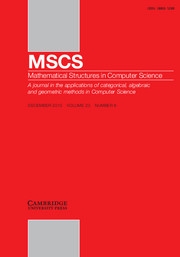No CrossRef data available.
Article contents
A parametricity-based formalization of semi-simplicial and semi-cubical sets
Published online by Cambridge University Press: 23 June 2025
Abstract
Semi-simplicial and semi-cubical sets are commonly defined as presheaves over, respectively, the semi-simplex or semi-cube category. Homotopy type theory then popularized an alternative definition, where the set of  $n$-simplices or
$n$-simplices or  $n$-cubes are instead regrouped into the families of the fibers over their faces, leading to a characterization we call indexed. Moreover, it is known that semi-simplicial and semi-cubical sets are related to iterated Reynolds parametricity, respectively, in their unary and binary variants. We exploit this correspondence to develop an original uniform indexed definition of both augmented semi-simplicial and semi-cubical sets, and fully formalize it in Coq.
$n$-cubes are instead regrouped into the families of the fibers over their faces, leading to a characterization we call indexed. Moreover, it is known that semi-simplicial and semi-cubical sets are related to iterated Reynolds parametricity, respectively, in their unary and binary variants. We exploit this correspondence to develop an original uniform indexed definition of both augmented semi-simplicial and semi-cubical sets, and fully formalize it in Coq.
Information
- Type
- Special Issue: Advances in Homotopy type theory
- Information
- Copyright
- © The Author(s), 2025. Published by Cambridge University Press


